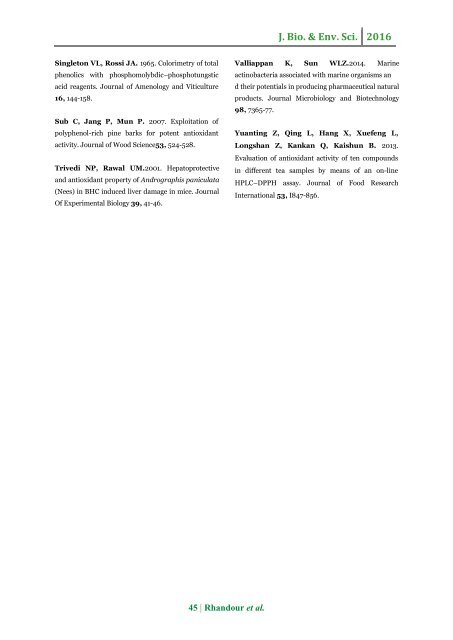Determination of polyphenols, tannins, flavonoids and antioxidant activity in extracts of two genus Ircinia marine sponges of Atlantic Morrocan coast
Marine sponges are multicellular invertebrates that are part of the marine biomass from the Lower Cambrian period. They are present all over the planet and live in many aquatic ecosystems. It is found that the marine sponges are the source of the greatest number of metabolites isolated and characterized. These metabolites can beings present in high concentrations. This study is focused on the quantitative identification of organic substances such as: polyphenols, tannins, and flavonoids found in the extracts of two genus Ircinia marine sponges ‘spinulosa & oros’ of Atlantic Morrocan coast by various methods. The results of this study indicate that the extracts of Ircinia spinulosa are rich in flavonoids 51.48 (±2.10) (Eq mg Quercetin/mg extract) and in Tannins 0.205 (±0.001) (mg Cya/g dry matter), and for the polyphenols, the highest was found in the extract of Ircinia oros 15.75 (±0.95) (mg GAE/g dry matter).The evaluation of the antioxidant potential with using the radical scavenging capacity DPPH. test show that the extracts of the two sponges of the genus Ircinia spinulosa &Oros contain antioxidant activity respectively 28.25%, & 9.34%. The antioxidant activity was observed in the crude extract of Ircinia spinulosa, which displayed a similar activity to synthetic BHT. Gas chromatography/mass spectroscopy (GC-MS) analysis of the extract revealed that the active compound was identical to synthetic BHT. The extracts sponges give good results, indicating that it possesses a significant amount of polyphenols, flavonoids, tannins, and an antioxidant activity.
Marine sponges are multicellular invertebrates that are part of the marine biomass from the Lower Cambrian period. They are present all over the planet and live in many aquatic ecosystems. It is found that the marine sponges are the source of the greatest number of metabolites isolated and characterized. These metabolites can beings present in high concentrations. This study is focused on the quantitative identification of organic substances such as: polyphenols, tannins, and flavonoids found in the extracts of two genus Ircinia marine sponges ‘spinulosa & oros’ of Atlantic Morrocan coast by various methods. The results of this study indicate that the extracts of Ircinia spinulosa are rich in flavonoids 51.48 (±2.10) (Eq mg Quercetin/mg extract) and in Tannins 0.205 (±0.001) (mg Cya/g dry matter), and for the polyphenols, the highest was found in the extract of Ircinia oros 15.75 (±0.95) (mg GAE/g dry matter).The evaluation of the antioxidant potential with using the radical scavenging capacity DPPH. test show that the extracts of the two sponges of the genus Ircinia spinulosa &Oros contain antioxidant activity respectively 28.25%, & 9.34%. The antioxidant activity was observed in the crude extract of Ircinia spinulosa, which displayed a similar activity to synthetic BHT. Gas chromatography/mass spectroscopy (GC-MS) analysis of the extract revealed that the active compound was identical to synthetic BHT. The extracts sponges give good results, indicating that it possesses a significant amount of polyphenols, flavonoids, tannins, and an antioxidant activity.
You also want an ePaper? Increase the reach of your titles
YUMPU automatically turns print PDFs into web optimized ePapers that Google loves.
J. Bio. & Env. Sci. 2016<br />
S<strong>in</strong>gleton VL, Rossi JA. 1965. Colorimetry <strong>of</strong> total<br />
phenolics with phosphomolybdic–phosphotungstic<br />
acid reagents. Journal <strong>of</strong> Amenology <strong>and</strong> Viticulture<br />
16, 144-158.<br />
Sub C, Jang P, Mun P. 2007. Exploitation <strong>of</strong><br />
polyphenol-rich p<strong>in</strong>e barks for potent <strong>antioxidant</strong><br />
<strong>activity</strong>. Journal <strong>of</strong> Wood Science53, 524-528.<br />
Trivedi NP, Rawal UM.2001. Hepatoprotective<br />
<strong>and</strong> <strong>antioxidant</strong> property <strong>of</strong> Andrographis paniculata<br />
(Nees) <strong>in</strong> BHC <strong>in</strong>duced liver damage <strong>in</strong> mice. Journal<br />
Of Experimental Biology 39, 41-46.<br />
Valliappan K, Sun WLZ.2014. Mar<strong>in</strong>e<br />
act<strong>in</strong>obacteria associated with mar<strong>in</strong>e organisms an<br />
d their potentials <strong>in</strong> produc<strong>in</strong>g pharmaceutical natural<br />
products. Journal Microbiology <strong>and</strong> Biotechnology<br />
98, 7365-77.<br />
Yuant<strong>in</strong>g Z, Q<strong>in</strong>g L, Hang X, Xuefeng L,<br />
Longshan Z, Kankan Q, Kaishun B. 2013.<br />
Evaluation <strong>of</strong> <strong>antioxidant</strong> <strong>activity</strong> <strong>of</strong> ten compounds<br />
<strong>in</strong> different tea samples by means <strong>of</strong> an on-l<strong>in</strong>e<br />
HPLC–DPPH assay. Journal <strong>of</strong> Food Research<br />
International 53, I847-856.<br />
45 | Rh<strong>and</strong>our et al.

















